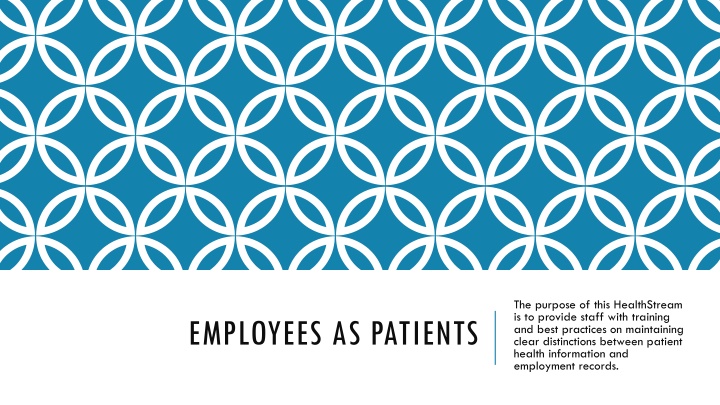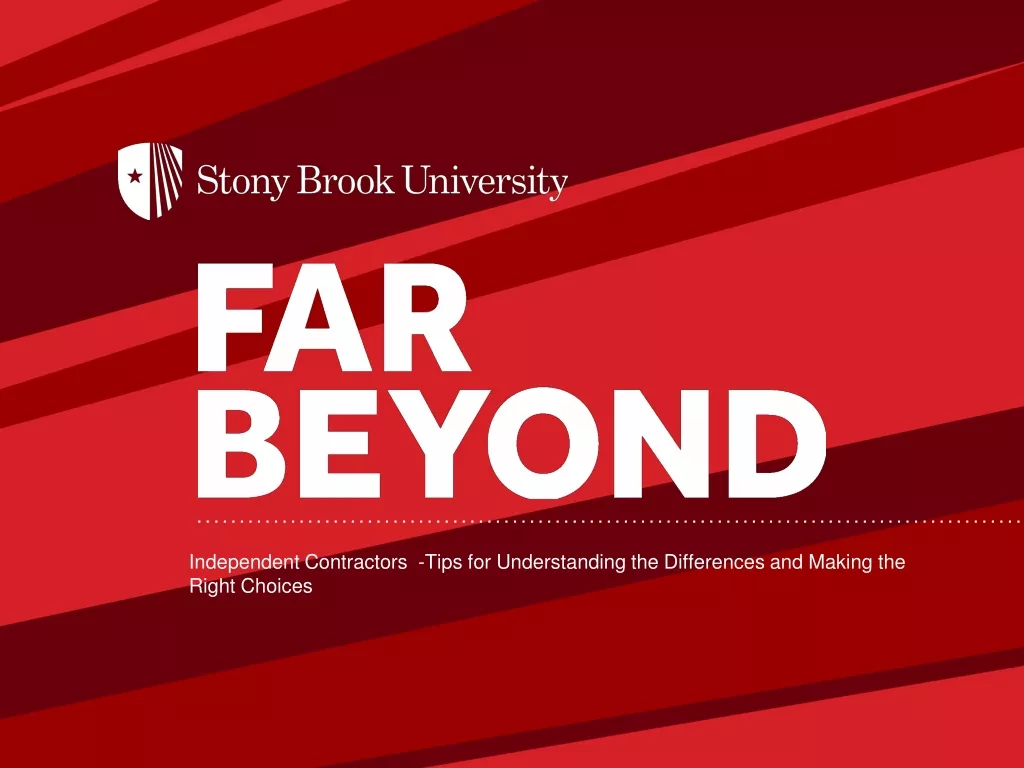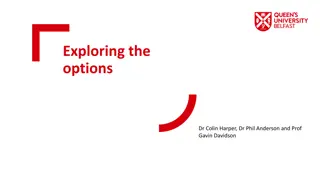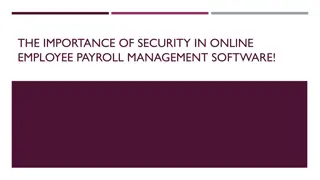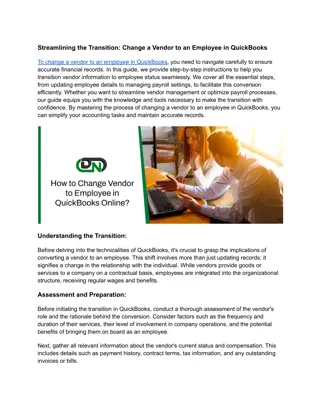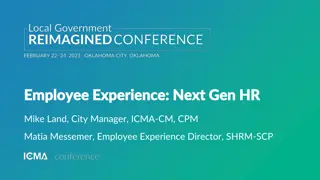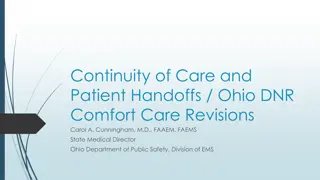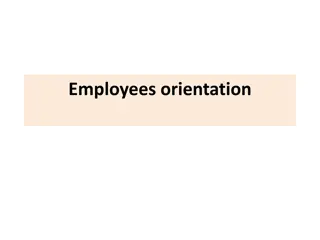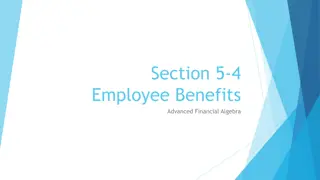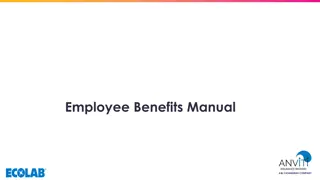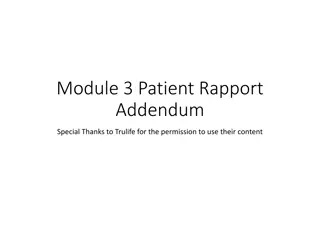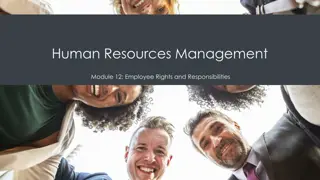Maintaining Patient and Employee Health Information Distinctions
This HealthStream aims to train staff on distinguishing between patient health information and employment records. ANTHC emphasizes the importance of understanding the differences between employee health information and protected health information. It outlines protocols for employees who are seen as patients, receiving confidential care without fear of retaliation. Providing healthcare to colleagues as patients requires strict confidentiality under HIPAA. ANTHC ensures that employee rights and responsibilities are upheld in healthcare settings at ANMC.
Download Presentation

Please find below an Image/Link to download the presentation.
The content on the website is provided AS IS for your information and personal use only. It may not be sold, licensed, or shared on other websites without obtaining consent from the author.If you encounter any issues during the download, it is possible that the publisher has removed the file from their server.
You are allowed to download the files provided on this website for personal or commercial use, subject to the condition that they are used lawfully. All files are the property of their respective owners.
The content on the website is provided AS IS for your information and personal use only. It may not be sold, licensed, or shared on other websites without obtaining consent from the author.
E N D
Presentation Transcript
The purpose of this HealthStream is to provide staff with training and best practices on maintaining clear distinctions between patient health information and employment records. EMPLOYEES AS PATIENTS
EMPLOYEE HEALTH INFORMATION AND PROTECTED HEALTH INFORMATION Like many healthcare providers, ANTHC is also an employer. In its dual role, ANTHC holds health information in both capacities. Information related to an employee s health is categorized as employee health information and information related to an individual receiving medical care as an ANMC patient is categorized as protected health information (PHI). ANTHC employees must understand employee health information and PHI are different and they have different confidentiality requirements. Otherwise, we are at risk of violating an individual s patient privacy rights or failing to uphold workplace safety requirements that an individual is responsible for adhering to as an employee.
EMPLOYEES WHO ARE SEEN AS PATIENTS If you receive health care from ANMC, outside of an employee health process, then you are being seen as a patient. Employees seen as patients must be treated just as any other patient. It does not matter if you are an Alaska Native beneficiary or a non-beneficiary patient. This includes being tested for COVID-19, unless you are being tested through an ANTHC Employee Health process. Employees seen as patients are provided confidential care and the patient has the right to make a complaint or bring forward concerns without fear of retaliation. Employees seen as patients are subject to ANMC s Patient Rights and Responsibilities, not ANTHC s workforce requirements, while being seen as a patient.
PROVIDING HEALTHCARE TO A COLLEAGUE If you are providing care to another ANTHC employee who presents for care as a patient, this care is confidential under HIPAA. It may NOT be shared with the employee s supervisor or the employee s coworkers. If an ANMC provider has concerns about something an employee does or says when they are being seen as a patient, these concerns may not be shared with the patient s ANTHC supervisor or HR without patient consent, unless some other HIPAA exception applies that would allow the sharing. For example, it is a violation of HIPAA to say something like: o Susie wasn t faking being sick, I saw her in the clinic yesterday. o What happened to Danny? I saw his name on the ED tracking board. o Tom was really rude when he checked in to my clinic yesterday.
WHAT ARE MY RIGHTS AS PATIENT/EMPLOYEE? If you are an ANTHC employee who receives care at ANMC as a patient: The HIPAA Privacy Rule protects your information as a patient. If you receive care at ANMC. Information about you as a patient cannot be used to make any employment decision about you. You have the same rights and responsibilities as any other patient, including the right to privacy. ANTHC may not use your patient medical record to make employment decisions, without your authorization. The HIPAA Privacy Rule prohibits the use of your patient health records, including clinical information regarding an employee s immunization status or exposures, by supervisors, human resources managers, or others. A supervisor can access the health information in your HR Files or Employee Health s records; but a supervisor is PROHIBITED from checking your patient medical record (unless they are also your treating provider). The HIPAA Privacy Rule does not apply to your employment records. Even if those records include health-related information, such as records of required immunizations or TB tests or supporting documents for FMLA leave.
ARE MY EMPLOYEE HEALTH RECORDS CONFIDENTIAL? Yes. Employee health records are subject to laws and may be shared only as required to perform necessary job duties. Example: A supervisor can review employee health information, like a return to work note, to make sure you can safely perform your job. But, a curious co-worker cannot. Why aren t employment records protected by HIPAA? HIPAA applies to Protected Health Information or PHI. HIPAA defines PHI in regulation. The regulatory language excludes employment records maintained by a healthcare organization in its capacity as an employer from the definition of protected health information.
RECEIVING PATIENT CARE DURING WORK HOURS What about an employee who picks up medication or is seen during normal work hours? One of the perks of being an employee and a patient at ANTHC is having the ability to schedule appointments during a lunch break or pick up medications before or after a shift. If the individual is acting as a patient, the care team must treat this information as confidential under HIPAA, including when the person was seen. A supervisor can address an employee s attendance or use of work time for personal tasks, but the supervisor should not access the medical record or be given the employee s patient information for use in tracking time or behavior. Even as an FYI.
HOW DO I KNOW IF HEALTH INFORMATION IS PART OF AN EMPLOYEE RECORD OR A PATIENT RECORD? Health information may look the same, but employee records and patient records are kept separately: Employment records: Employee information is maintained by Human Resources, by Employee Health, or a supervisor. The main electronic systems used are MyHR or the records in the EHR in an employee health facility. These records include Employee in the patient name field to make them easy to identify. Patient records: Patient information is stored in the Electronic Health Record and in other applications that pull information from the EHR, such as HealthCatalyst or the Business Intelligence portals.
IF YOU ARE NOT SURE, THEN ASK A SUPERVISOR OR COMPLIANCE FOR ASSISTANCE BEFORE DISCLOSING THE INFORMATION TO THE EMPLOYEE S SUPERVISOR OR HR.
1. ANTHC holds health information in which two capacities? a) A health care provider and an insurance agent b) An insurance agent and an employer c) A health care provider and an employer d) An employee and a nurse 2. Employees who are seen as patients must be treated: a) just as any other patient b) different than other patients c) based on their seniority d) without any respect to confidentiality 3. I am an employee being tested for COVID-19 in a patient care setting. My supervisor has a right to know about my patient experience without my consent? a) True b) False
4. The HIPAA Privacy Rule protects my employees health information when they are seen as patients? a) True b) False 5. I heard my employee left his clinic appointment disgruntled. Do I have to discipline my employee to let him know that this type of behavior is unacceptable? a) Yes b) No.
